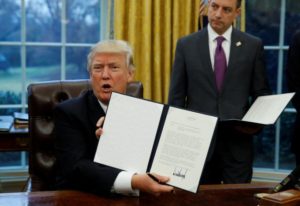![]()

President Donald Trump shows the press his newly signed executive order. The order will be reviewed and examined to see if its contents violate constitutional laws.
President Trump issued 11 executive orders during his first 20 days in office ranging from plans to repeal the Affordable Care Act, to ambitions to hone in on crime and international trafficking laws.
Christa Jackson, senior biology major, commented on the role of executive orders, saying, “I like seeing the whole process of the executive orders made and fought against. It is a good example of our government’s checks and balances at work.”
Each executive order begins with a clear purpose of what the policy is meant to do. Further, each order contains direction, permissions and guidance to members of the cabinet for governing their respective area of responsibility. The number of specific “shall” statements and orders from the president to particular appointees is about 25 items on average over the 11 orders. The following is a summary of a few of the executive orders published by President Trump to date.
Executive Order: Minimizing the Economic Burden of the Patient Protection and Affordable Care Act Pending Repeal. This order gives direction to begin plans to repeal the Affordable Care Act in favor of a “more free and open healthcare market.” This empowers state governments to decide on health insurance matters while promoting an interstate health insurance market.
Executive Order: Expediting Environmental Reviews and Approvals for High Priority Infrastructure Projects. This order empowers the Chairmen of the Council on Environmental Quality to work with environmental and high-value projects that are deemed as “high priority.” The CEQ is to work with various leaders of other government agencies to create an expedited approval process such that high-priority projects are approved and executed with minimal delay.
Executive Order: Protecting The Nation from Foreign Terrorist Entry into The United States. This order strengthens the measures that the State Department takes to ensure that any actor with motives of terror against the United States do not enter. The order defines the policy of the United States to be against the admission of any foreign nationals who intend to exploit the U.S. immigration laws “for malevolent purposes.” Further, the order placed an immediate suspension of any foreign national from a list of seven majority Muslim countries from entering the United States for 90 days beginning Jan. 27, 2017, excluding only certain types of visas. The order requires every foreigner to cooperate and provide predetermined information to U.S. officials and that failing to do so would result in the denial of entry into the U.S. of foreign nationals from such countries. This order, from its date of publication, halts refugee entry via the U.S. Refugee Admissions Program for 120 days. It also places a cap on the number of refugees allowed to enter the U.S. in fiscal year 2017 at 50,000, requires the Secretary of Homeland Security to make reports of religious-based persecution, and expands the Consular Fellows Program, which promotes efficient visa-interview processing.
Justin Jabbour, senior graphic design major, commented on the Executive Order on terrorism, saying, “I have trouble accepting that the executive orders are constitutional, especially this one. I don’t see how it protects people since he seems to have selectively chosen countries where he has no business interest.”
Executive Order: Ethics Commitments by Executive Branch. This order promotes ethical standards for any appointee to the executive branch with few exceptions, such as a member of the Senior Foreign Service or a uniformed service commissioned officer. The order prevents conflicts of interest between executive appointees and organizations such as lobbyist groups. matters of gift-receiving, and private business ventures.




